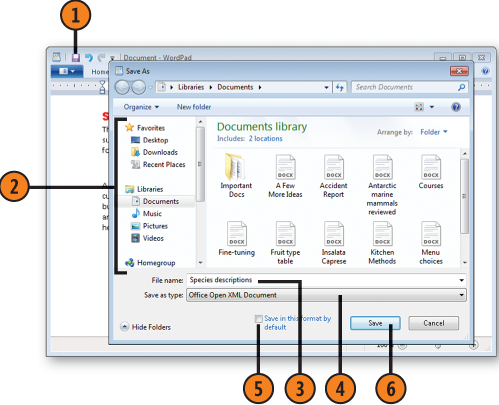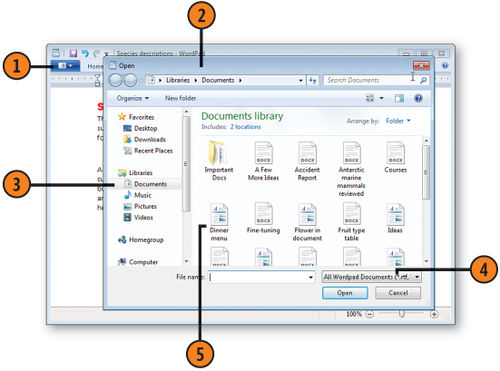After you've created a
document, you'll probably want to save it for later use. When you've
finished creating the document, close the program in which you created
it so that the program isn't using space or taking power from your
computer. When you're ready to work on your document again, you can
easily restart the program and open the document directly from the running program.
1. Save a Document
Click the Save button on the toolbar, or, if the toolbar isn't visible, choose Save from either the Program menu (for programs that use the Ribbon) or the File menu.
If
you don't want to save the document to the default library or folder,
specify a different location. If the libraries or folders aren't shown,
click the Browse Folders button.
Type a name for the document. The name can be up to 255 characters
long (including any path and file extension); it can contain spaces but
can't contain the * : < > | " \ or / characters. Note that long
file names are often truncated by programs, so a descriptive short name
is best.
If you want to save the document in a different format from that of the default file format, select the format.
Select this check box if you want to make the selected format the default format in which to save files.
Click
Save. As you work with the document, click Save frequently. In many
programs, you can press Ctrl+S to quickly save a document. Windows will
now save the file without displaying the Save As dialog box.

Note:
Try This!
Many programs can stay
open for additional work even after you close the document you're
working on. Open the Program or the File menu and look at the commands.
If there's a Close command, click it to close the document without
closing the program. If there's a New command but no Close command,
choose New to see whether it closes the open document.
2. Close a Document
Click the Save button one last time to make sure you've saved all the changes in the document.
Click the Close button to end the program.
3. Open a Document
With
the program you want to use running, click the Program button or open
the File menu, and click the document you want if it's displayed in the
Recent list.
If
the document isn't listed, choose Open from either the Program menu
(for programs that use the Ribbon) or the File menu to display the Open
dialog box.
If necessary, specify the location of the document you want.
If
necessary, specify the file type of the document you want to open. Only
documents of the specified file type will be displayed in the list of files.
Double-click the document to open it.
Tip:
If you're unsure about which file you want, select a file and then click Show The Preview Pane to view the contents of the file. However, note that not all file types can be displayed in the Preview pane.

